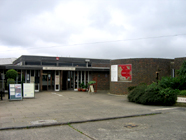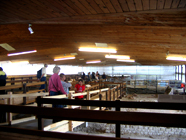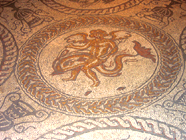|
Fishbourne roman palace
Fishbourne Roman Palace
Salthill Road,
Fishbourne PO19 3QR
West Sussex - Great Britain.
Tel : +44 (0) 1243 785859
E-mail: adminfish@sussexpast.co.uk
Managed by: The Sussex Archaeological Society
Number of visitors: 80,000 per annum
Internet address:
www.sussexpast.co.uk
In the county of West Sussex, on the south coast of England. Approximately 1_ miles (2km) from Chichester, 15 mile (21km) from Portsmouth and 45 miles (70km) south-west of London.
Apart from the villas situated close to Pompeii, this is the most visited Roman private dwelling in Europe. The large collection of in-situ mosaic floors is protected by a vast cover building. Larger than a villa, this could have been the home of a Romano-British king; hence the name of Roman Palace.
.......................................................................
.......................................................................
General information
Where?
Sign-posted from the A27 and A259, 1_ miles (2km) from Chichester. Near Fishbourne railway station, bus stop nearby.
Nearby towns: 36 miles (50km) East of Brighton and 65 miles (104km) south of London.
When ?
Open every day at 10.00 from 1st February to 15th of December, weekends only from 16th December to 31st January. Closing times vary according to the seasons: 4pm from November to February, 6pm in August, 5pm at other times.
How ?
Self guided but with optional guided tours at week-end and during school holidays or by arrangement when possible.
Ample parking – Shop – Cafeteria
.......................................................................
At Fishbourne, you will find...
… Remains of the north wing
Site discovered in 1960 and excavated extensively from 1961 to 1969. Remains of a very large first century building destroyed by fire in the third century: four wings (100 rooms) arranged around a rectangular garden. Only the northern part of the site has been excavated as the southern part is buried under houses and a road. The museum was opened to the public in 1968.
It is the largest Roman dwelling yet found in Great Britain, but its status as a ‘palace’ is open to question. Apart from the villas in Campania, it is the most visited Roman building in Europe.
...The numerous mosaics
It is surprising to find such a large number of fine, relatively-complete, first century, in-situ mosaic floors in one site. The wooden walkways might make it difficult to have an overall impression of the site, but they provide a good view of each mosaic pavement. At the far end of the building, you will find information on mosaic restoration.
...The reconstructed garden
The formal garden was replanted in the 1960’s. Other features (summer triclinium, orchard, research garden and museum) are more recent. In the 60s, such detailed excavations of a garden was a pioneering exercise. The replanting of the box hedges and the espalier trees is therefore based on archaeological findings. Do not forget to visit the gardener in his shed! He might be a little gruff but he is still a good guy (for a Roman), always ready to share his trade secrets. (An excellent diorama)
...The site museum
This is a true site museum. The artefacts are presented in a careful and interesting manner, a very ‘avant-garde’ style when it was designed in 1968. As so often in England, it has remained unchanged: a dark room lit only by the wall mounted illuminated display cabinets. The arrangement of significant objects tell the story of the site in chronological order.
Do not forget to visit the museum as it is tucked away on the left of the entrance door. Before you start the visit, have a look at the large model of the palace situated in the foyer.
...and in the area
Sussex is a county extremely rich in historical sites and well preserved small towns like Chichester.
Several other Roman villas nearby are open to the public: Bignor, 15 miles (24km) north-east of Chichester and , Brading and Newport on the Isle of Wight.
|




